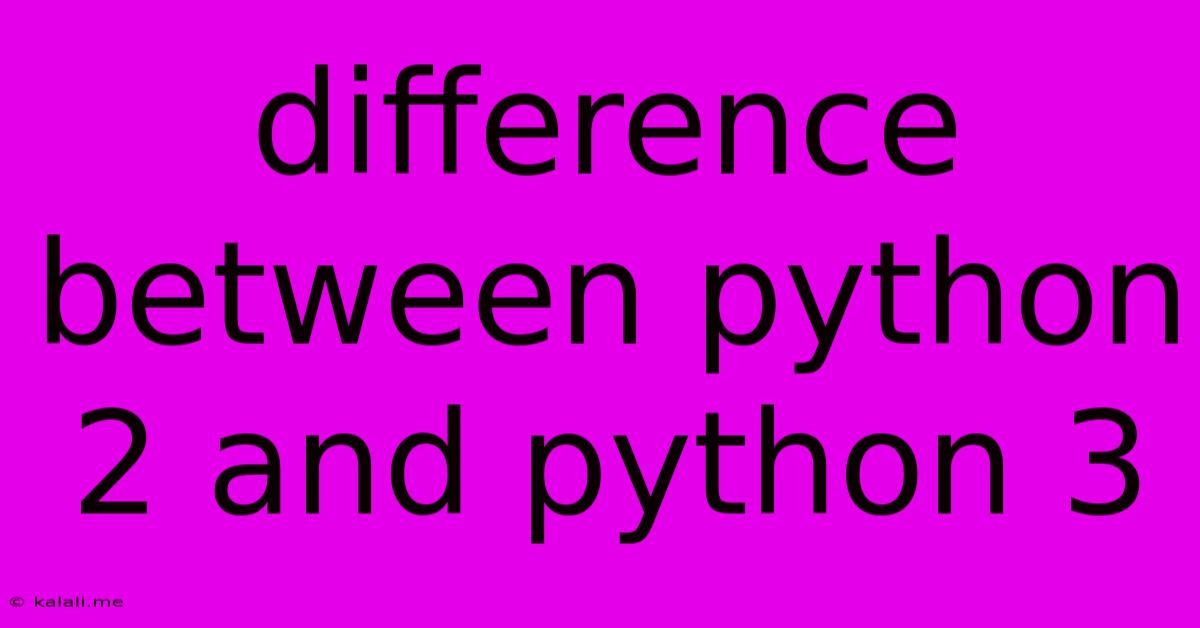Difference Between Python 2 And Python 3
Kalali
Jun 14, 2025 · 3 min read

Table of Contents
Python 2 vs. Python 3: A Comprehensive Comparison for Developers
Choosing between Python 2 and Python 3 can be a crucial decision for any developer. While Python 2 is officially sunsetted, understanding its differences from Python 3 remains important, especially when dealing with legacy code or specific libraries. This article delves into the key distinctions between these two versions, helping you navigate the complexities and make informed choices for your projects. This guide covers print statements, integer division, Unicode handling, and library compatibility, equipping you with the knowledge to confidently choose the right Python version.
Key Differences Between Python 2 and Python 3:
Python 3 was designed to address some of the inconsistencies and limitations present in Python 2. The transition involved significant changes, making direct compatibility challenging. Here's a breakdown of the core differences:
1. Print Statement:
- Python 2: Uses
printas a statement:print "Hello, world!" - Python 3:
print()is a function:print("Hello, world!")This seemingly minor change highlights the shift towards a more consistent and functional programming paradigm in Python 3. The function-based approach allows for greater flexibility and control over output.
2. Integer Division:
- Python 2: Integer division truncates the result. For example,
5 / 2equals2. - Python 3: Integer division uses true division, so
5 / 2equals2.5. To get the truncated integer result in Python 3, you would use the floor division operator//, resulting in5 // 2 = 2. This change enhances mathematical consistency and reduces unexpected behavior.
3. Unicode Handling:
- Python 2: Requires explicit declaration for Unicode strings using
u"string". This often leads to encoding issues. - Python 3: Uses Unicode by default, simplifying internationalization and reducing the likelihood of encoding errors. Strings are Unicode by default, making it simpler to handle text from various languages and character sets. This is a significant improvement for globalized applications.
4. xrange vs. range:
- Python 2:
xrangegenerates a sequence of numbers on demand, improving memory efficiency for large ranges.rangecreates a list in memory. - Python 3:
xrangeis gone!rangenow behaves like Python 2'sxrange, generating numbers on demand for better memory management.
5. Library Compatibility:
This is a major point of consideration. Many libraries still support Python 2, but the community's focus has shifted to Python 3. While some libraries might have Python 2 and 3 versions, others may only support the newer version. Choosing Python 3 ensures better access to up-to-date and actively maintained packages. This aspect directly influences your project's longevity and maintainability.
6. Exception Handling:
- Python 2: Uses the comma to separate exception types in
exceptblocks. - Python 3: Requires parentheses to group exception types in
exceptblocks. This change improves readability and reduces potential ambiguity.
Choosing the Right Version:
For new projects, Python 3 is the clear choice. It offers improved features, better performance in some areas, and a vibrant, actively developed ecosystem. Only when dealing with existing Python 2 projects or libraries that lack Python 3 support should you consider sticking with Python 2, but even then, migration to Python 3 is often a worthwhile investment in the long run. Remember to consider the long-term maintainability and community support when making your decision. The future of development is undeniably with Python 3.
Latest Posts
Latest Posts
-
Least Common Multiple Of 18 And 32
Jun 14, 2025
-
What Is The Storage Form Of Glucose In Animals
Jun 14, 2025
-
What Percent Of Land Is On Earth
Jun 14, 2025
-
Graph Of A Second Order Reaction
Jun 14, 2025
-
In Right Triangle Rst The Sum Of The Measures
Jun 14, 2025
Related Post
Thank you for visiting our website which covers about Difference Between Python 2 And Python 3 . We hope the information provided has been useful to you. Feel free to contact us if you have any questions or need further assistance. See you next time and don't miss to bookmark.